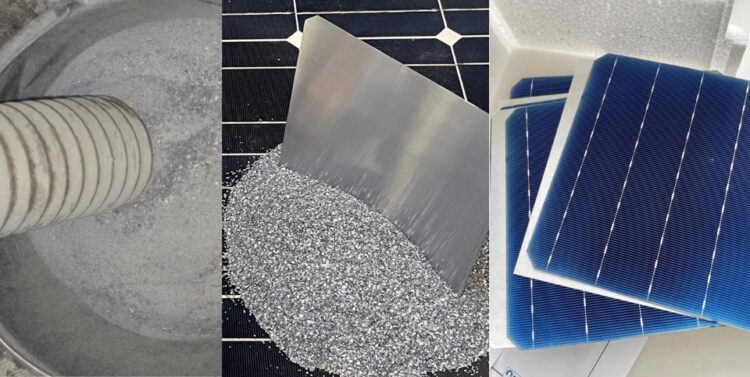PERC Solar Cells from 100 Percent Recycled Silicon

By-products of the treatment process at Reiling GmbH, from which the solar cell fragments are separated and collected (left). Purified silicon and wafers made from 100% recycled silicon (middle). PERC solar cells made of 100 % recycled silicon with an efficiency of 19.7 percent (right).
© Fraunhofer ISE
Around ten thousand tons of silicon in discarded photovoltaic modules end up on the recycling market annually in Germany. This figure will rise to several hundred thousand tons per year by 2029. Currently, the aluminum, glass and copper of the discarded modules are reprocessed, however, the silicon solar cells are not.
In order to be able to reuse the silicon, researchers from the Fraunhofer Center for Silicon Photovoltaics CSP and the Fraunhofer Institute for Solar Energy Systems ISE together with the largest German recycling company for PV modules, Reiling GmbH & Co. KG, have developed a solution, in which the silicon in the discarded modules was recycled on an industrial scale and reused to produce new PERC solar cells.
Around ten thousand tons of silicon in discarded photovoltaic modules end up on the recycling market annually in Germany. This figure will rise to several hundred thousand tons per year by 2029. Currently, the aluminum, glass and copper of the discarded modules are reprocessed, however, the silicon solar cells are not. In order to be able to reuse the silicon, a working group from the Fraunhofer Institute for Solar Energy Systems ISE and the largest German recycling company for PV modules, Reiling GmbH & Co. KG, have developed a solution at the Fraunhofer Center for Silicon Photovoltaics CSP in Halle (Saale), in which the silicon in the discarded modules was recycled on an industrial scale and reused to produce new PERC solar cells.
Most PV systems in Germany were installed between 2009 and 2011 during the first wave of photovoltaic expansion. “This expansion will foreseeably be followed by a first wave of disposal twenty years later, around 2029, when the feed-in tariff for the installed PV modules expires,” explains Prof. Dr. Andreas Bett, Institute Director of Fraunhofer ISE. “Therefore, it is necessary to establish adequate processes and procedures for recovering the silicon material from the discarded modules at an early stage.” Already in 2021, the total installed quantity of PV modules in Germany was about five million tons, with a silicon content of 150,000 tons. As a semiconductor material, silicon is the main component of solar cells.
A working group at Fraunhofer CSP, together with Reiling GmbH & Co. KG, has therefore developed a process for recovering the silicon material with funding from the German Federal Ministry for Economic Affairs and Climate BMWK (formerly BMWi). With this process, it is possible to recycle all crystalline silicon PV modules, regardless of manufacturer and origin. Prof. Dr. Peter Dold, project manager at Fraunhofer CSP, explains: “If this were not the case, then this would be far too much work for the recycling companies. It was important for us to develop a scalable process that makes economic sense. A lot is possible in the lab, but our new process should prove itself in the practice for the recycling industry.”
For the process, solar cell fragments are separated and collected from by-products of the mechanical recycling process, which is already established. At Fraunhofer CSP, the cell fragments with sizes from 0.1 to 1 millimeter are first freed from the glass and plastic by various sorting processes. This is followed by the step-by-step removal of the backside contact, the silver contacts, the anti-reflective layer and finally the emitter by wet chemical etching. The silicon cleaned in this way is processed into monocrystalline or quasi-monocrystalline ingots in standard processes and then into wafers.
The crystallization is carried out with 100 percent recycled silicon without the addition of commercial ultrapure silicon. The wafers made of recycled silicon were fabricated into PERC solar cells at Fraunhofer ISE’s PV-TEC. In the first trial, the solar cell conversion efficiency was 19.7 percent. “This is below the efficiency of today’s premium PERC solar cells, which have an efficiency of around 22.2 percent, but it is certainly above that of the solar cells in the old, discarded modules,” says Dold, putting the initial results into context.”
Weitere Informationen:
https://www.ise.fraunhofer.de/en/press-media/press-releases/2022/solar-cells-fro…
Media Contact
All latest news from the category: Materials Sciences
Materials management deals with the research, development, manufacturing and processing of raw and industrial materials. Key aspects here are biological and medical issues, which play an increasingly important role in this field.
innovations-report offers in-depth articles related to the development and application of materials and the structure and properties of new materials.
Newest articles

Innovative 3D printed scaffolds offer new hope for bone healing
Researchers at the Institute for Bioengineering of Catalonia have developed novel 3D printed PLA-CaP scaffolds that promote blood vessel formation, ensuring better healing and regeneration of bone tissue. Bone is…

The surprising role of gut infection in Alzheimer’s disease
ASU- and Banner Alzheimer’s Institute-led study implicates link between a common virus and the disease, which travels from the gut to the brain and may be a target for antiviral…

Molecular gardening: New enzymes discovered for protein modification pruning
How deubiquitinases USP53 and USP54 cleave long polyubiquitin chains and how the former is linked to liver disease in children. Deubiquitinases (DUBs) are enzymes used by cells to trim protein…



